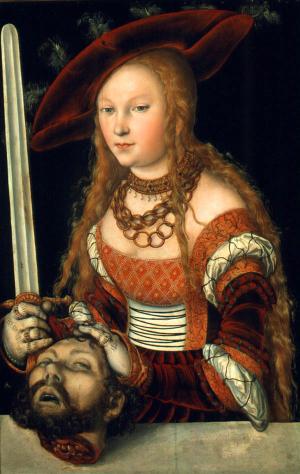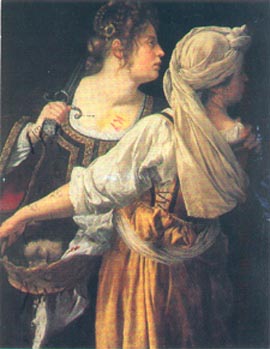


My favorite painting is Masimo Stanzione's Judith with the Head of Holfernes. It was made in the 17th century, and the copyright, since then, has probably lapsed. But I can't scan this thing on screen for you, or even tell you where to find it, other than to point you vaguely in the direction of the Metropolitan Museum of Art in New York, where it hangs in the labyrinth known as European Painting on some northerly-facing wall. There are no postcards of it, and you can't even pay an exorbitant sum for a color reproduction, because the only book that has it reduces it to a 4" or so by 5" black and white. It is, suffice to say, not all that frequently reproduced.
The omission is a pity, because Stanzione's Judith is gorgeous and singular, and masterful enough to keep you idle for an hour, trying to memorize the lines of Judith's face. The last time I was there, three years ago, I stood there forever and failed to commit that face to memory, but being more worldly on my second try I can now give you a reasonable idea: Stanzione's Judith looks like Patricia Arquette.
There are a lot of Judiths out there, but most are similar in appearing, not as an individual, but as quintessential female types. There are vixen Judiths, like the 16th century German portrait, wherein she's blond and coy as Drew Barrymore in the bad old days. There are matron Judiths, like Artemisia Gentilischi's that depicts both her and maid looking over their shoulders in the dark. In this picture the head sits neatly in a basket balanced on the maid's hip and the sword rests on Judith's shoulder. The women could very easily be fishwives, struck by a strange noise on the long walk home.
There are butcher Judiths, like Artemisia's most famous work, depicting our girl mid-hack and Holfernes' blood mid-spurt, her chin set in workman-like concentration as she saws deliberately away. And finally, there are the Judiths that just stare at you. These Judiths are perhaps the most quintessential types of all.
John Berger, in his Ways of Seeing wrote that "it is true that sometimes a painting includes a male lover. But the woman's attention is very rarely directed towards him. Often she looks away from him or she looks out of the picture towards...the spectator-owner...it is clear that the spectator-owner will in fantasy oust the other man, or else identify with him." The purpose of these Judiths is to provide an object for the clear experience of a certain masculine ambivalence towards women. Granted, it is this very ambivalence that powers the biblical story, but the depictions produced in this category are always extreme. Judith is inevitably excessively feminized, with soft features, droopy eyes, pale skin. In each instance, if you could somehow excise the severed head, you would have a good example of contemporary female portraiture, of the flattering if not downright idolizing kind. Once the head is added, however, a kind of Rouseau-worthy warning is given about how a women will destroy a man with weakness, emasculate him with her very femininity. Sartre would appreciate this kind of thing. Harvey Mansfield would secretly agree.
Stanzione's Judith, suffice to say, is completely different. Since I don't have the picture, I will have to help you imagine her. (You might as well start with an image of Patricia Arquette.) Her costume is like the last painting here, only without the same luxury and mess. The dress is mainly yellow, (in the tarot, the color of intellect), the sash blue (for purity, and reflection), and both the sleeves and neck sport a thick bordering of red (red, I suspect, as in blood). She holds the head in one hand, a knife in the other, and her face is turned upwards. She looks for all the world to be in some private conversation with God.
It is always her expression that strikes me.
She seems troubled, and intent, and defiant. Unlike every other Judith, she looks like she knows she has murdered someone, and she seems weighted by the act. The red border at the neck of the dress emphasizes this. It suggests her crime, but also suggests that she accepts the guilt of it; she knows that whatever she does to another individual will reflect back in some way on her.
She clearly isn't sorry. Her face is set, and you get the distinct impression of a person who feels she has done the necessary, and would if necessary do it again. But with her upturned face she communicates this necessity to God; she demands acknowledgement of it. She is reminding him that she undertook to kill Holfernes to save God's people, and that she never would have succeeded without His help. She is not seeking absolution. You get the feeling she's trying to get her head around something; not just her new identity as murderess, but God's complicity in the killing. She demands that they witness each other, and be witnesses of each other. She is, it seems, making a very unquiet peace with Him.
This is understandable, because in a sense her whole world has changed. Judith's flight from Holfernes' camp is like a second flight from Eden. Only, what has been stripped from her and her unlikely Adam and all those who see her image is not immortality but the comfort of a world with consistent laws, where murder is not necessary and good people do not have bloody hands.
In short, the painting is about the nature and gravity of human actions. To that first question of ethics, 'do the lives of many outnumber the life of one'? this Judith has answered 'yes.' And she knows that she will have to live with that answer for the rest of her life. So far from being a female caricature, Stanzione's Judith is purely, simply human. Is this why she is so rarely reproduced?